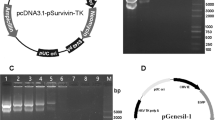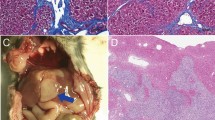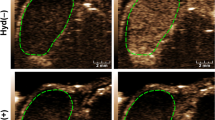Abstract
Cancer gene therapy has great potential for decreasing tumor-induced mortality but has been clinically limited by non-targeted and insufficient gene transfer. We evaluated gene therapy targeting hepatocellular carcinoma (HCC) using the herpes simplex virus thymidine kinase/ganciclovir (HSVtk/GCV) suicide gene system and the tissue inhibitor of metalloproteinase 3 (Timp3) gene. Ultrasound-targeted microbubble destruction (UTMD) targeted gene delivery to the tumor tissue, and the α-fetoprotein promoter targeted HSVtk expression to the HCC cells. Human HepG2 cells transfected with the HSVtk or Timp3 gene demonstrated a reduction in cell viability by >40% compared with the vector control. Cell viability was further inhibited by over 50% with co-transfection of the genes. HepG2 cells were inoculated subcutaneously into athymic mice to induce tumors. UTMD-mediated delivery of HSVtk or Timp3 suppressed tumor growth by >45% and increased survival of tumor-bearing animals (P<0.01 vs vector control). Co-delivery of the genes resulted in a further 30% improvement in tumor suppression and significant extension of animal survival (P<0.01 vs vector control). Targeted gene delivery increased the number of apoptotic cells and decreased the vascular density of the tumors. Targeted co-delivery of the genes synergistically improved the antitumor effects and may provide an effective therapy for HCC.
This is a preview of subscription content, access via your institution
Access options
Subscribe to this journal
Receive 12 print issues and online access
$259.00 per year
only $21.58 per issue
Buy this article
- Purchase on Springer Link
- Instant access to full article PDF
Prices may be subject to local taxes which are calculated during checkout






Similar content being viewed by others
References
Parkin DM, Bray F, Ferlay J, Pisani P . Global cancer statistics, 2002. CA Cancer J Clin 2005; 55: 74–108.
Colombo M . Hepatocellular carcinoma. J Hepatol 1992; 15: 225–236.
Venook AP . Treatment of hepatocellular carcinoma: too many options? J Clin Oncol 1994; 12: 1323–1334.
Venook AP . Hepatocellular carcinoma. Curr Treat Options Oncol 2000; 1: 407–415.
Fuss M, Salter BJ, Cavanaugh SX, Fuss C, Sadeghi A, Fuller CD et al. Daily ultrasound-based image-guided targeting for radiotherapy of upper abdominal malignancies. Int J Radiat Oncol Biol Phys 2004; 59: 1245–1256.
Ganne-Carrie N, Trinchet JC . Systemic treatment of hepatocellular carcinoma. Eur J Gastroenterol Hepatol 2004; 16: 275–281.
Ren W, Strube R, Zhang X, Chen SY, Huang XF . Potent tumor-specific immunity induced by an in vivo heat shock protein-suicide gene-based tumor vaccine. Cancer Res 2004; 64: 6645–6651.
Gerolami R, Uch R, Faivre J, Garcia S, Hardwigsen J, Cardoso J et al. Herpes simplex virus thymidine kinase-mediated suicide gene therapy for hepatocellular carcinoma using HIV-1-derived lentiviral vectors. J Hepatol 2004; 40: 291–297.
Krohne TU, Shankara S, Geissler M, Roberts BL, Wands JR, Blum HE et al. Mechanisms of cell death induced by suicide genes encoding purine nucleoside phosphorylase and thymidine kinase in human hepatocellular carcinoma cells in vitro. Hepatology 2001; 34: 511–518.
Ezzeddine ZD, Martuza RL, Platika D, Short MP, Malick A, Choi B et al. Selective killing of glioma cells in culture and in vivo by retrovirus transfer of the herpes simplex virus thymidine kinase gene. New Biol 1991; 3: 608–614.
Heyman RA, Borrelli E, Lesley J, Anderson D, Richman DD, Baird SM et al. Thymidine kinase obliteration: creation of transgenic mice with controlled immune deficiency. Proc Natl Acad Sci USA 1989; 86: 2698–2702.
Chen XP, Zhao H, Zhao XP . Alternation of AFP-mRNA level detected in blood circulation during liver resection for HCC and its significance. World J Gastroenterol 2002; 8: 818–821.
Johnson PJ . Role of alpha-fetoprotein in the diagnosis and management of hepatocellular carcinoma. J Gastroenterol Hepatol 1999; 14 Suppl: S32–S36.
Ala-aho R, Kahari VM . Collagenases in cancer. Biochimie 2005; 87: 273–286.
Ahonen M, Ala-aho R, Baker AH, George SJ, Grenman R, Saarialho-Kere U et al. Antitumor activity and bystander effect of adenovirally delivered tissue inhibitor of metalloproteinases-3. Mol Ther 2002; 5: 705–715.
Ahonen M, Poukkula M, Baker AH, Kashiwagi M, Nagase H, Eriksson JE et al. Tissue inhibitor of metalloproteinases-3 induces apoptosis in melanoma cells by stabilization of death receptors. Oncogene 2003; 22: 2121–2134.
Baker AH, George SJ, Zaltsman AB, Murphy G, Newby AC . Inhibition of invasion and induction of apoptotic cell death of cancer cell lines by overexpression of TIMP-3. Br J Cancer 1999; 79: 1347–1355.
Finan KM, Hodge G, Reynolds AM, Hodge S, Holmes MD, Baker AH et al. In vitro susceptibility to the pro-apoptotic effects of TIMP-3 gene delivery translates to greater in vivo efficacy versus gene delivery for TIMPs-1 or -2. Lung Cancer 2006; 53: 273–284.
Bachman KE, Herman JG, Corn PG, Merlo A, Costello JF, Cavenee WK et al. Methylation-associated silencing of the tissue inhibitor of metalloproteinase-3 gene suggest a suppressor role in kidney, brain, and other human cancers. Cancer Res 1999; 59: 798–802.
Gu P, Xing X, Tanzer M, Rocken C, Weichert W, Ivanauskas A et al. Frequent loss of TIMP-3 expression in progression of esophageal and gastric adenocarcinomas. Neoplasia 2008; 10: 563–572.
Fujii H, Sun Z, Li SH, Wu J, Fazel S, Weisel RD et al. Ultrasound-targeted gene delivery induces angiogenesis after a myocardial infarction in mice. JACC Cardiovasc Imaging 2009; 2: 869–879.
Fujii H, Li SH, Wu J, Miyagi Y, Yau TM, Rakowski H et al. Repeated and targeted transfer of angiogenic plasmids into the infarcted rat heart via ultrasound targeted microbubble destruction enhances cardiac repair. Eur Heart J 2011; 32: 2075–2084.
Zhou S, Li S, Liu Z, Tang Y, Wang Z, Gong J et al. Ultrasound-targeted microbubble destruction mediated herpes simplex virus-thymidine kinase gene treats hepatoma in mice. J Exp Clin Cancer Res 2010; 29: 170.
Tian H, Huang ML, Liu KY, Jia ZB, Sun L, Jiang SL et al. Inhibiting matrix metalloproteinase by cell-based TIMP-3 gene transfer effectively treats acute and chronic ischemic cardiomyopathy. Cell Transplant 2012; 21: 1039–1053.
Smith DA, Porter TM, Martinez J, Huang S, MacDonald RC, McPherson DD et al. Destruction thresholds of echogenic liposomes with clinical diagnostic ultrasound. Ultrasound Med Biol 2007; 33: 797–809.
Anderson WF . Human gene therapy. Nature 1998; 392: 25–30.
Marshall E . Gene therapy death prompts review of adenovirus vector. Science 1999; 286: 2244–2245.
Lentacker I, De Geest BG, Vandenbroucke RE, Peeters L, Demeester J, De Smedt SC et al. Ultrasound-responsive polymer-coated microbubbles that bind and protect DNA 55. Langmuir 2006; 22: 7273–7278.
Panje C, Wang DS, Pysz MA, Paulmurugan R, Ren Y, Tranquart F et al. Ultrasound-mediated gene delivery with cationic versus neutral microbubbles: effect of DNA and microbubble dose on in vivo transfection efficiency. Theranostics 2012; 2: 1078–1091.
Sun L, Huang CW, Wu J, Chen KJ, Li SH, Weisel RD et al. The use of cationic microbubbles to improve ultrasound-targeted gene delivery to the ischemic myocardium 67. Biomaterials 2013; 34: 2107–2116.
Carson AR, McTiernan CF, Lavery L, Hodnick A, Grata M, Leng X et al. Gene therapy of carcinoma using ultrasound-targeted microbubble destruction. Ultrasound Med Biol 2011; 37: 393–402.
Tang Q, He X, Liao H, He L, Wang Y, Zhou D et al. Ultrasound microbubble contrast agent-mediated suicide gene transfection in the treatment of hepatic cancer. Oncol Lett 2012; 4: 970–972.
Hanke P, Serwe M, Dombrowski F, Sauerbruch T, Caselmann WH . DNA vaccination with AFP-encoding plasmid DNA prevents growth of subcutaneous AFP-expressing tumors and does not interfere with liver regeneration in mice. Cancer Gene Ther 2002; 9: 346–355.
Horst M, Brouwer E, Verwijnen S, Rodijk M, de JM, Hoeben R et al. Targeting malignant gliomas with a glial fibrillary acidic protein (GFAP)-selective oncolytic adenovirus. J Gene Med 2007; 9: 1071–1079.
McKie EA, Graham DI, Brown SM . Selective astrocytic transgene expression in vitro and in vivo from the GFAP promoter in a HSV RL1 null mutant vector--potential glioblastoma targeting. Gene Ther 1998; 5: 440–450.
Vollmer CM Jr., Eilber FC, Butterfield LH, Ribas A, Dissette VB, Koh A et al. Alpha-fetoprotein-specific genetic immunotherapy for hepatocellular carcinoma. Cancer Res 1999; 59: 3064–3067.
Elshami AA, Saavedra A, Zhang H, Kucharczuk JC, Spray DC, Fishman GI et al. Gap junctions play a role in the 'bystander effect' of the herpes simplex virus thymidine kinase/ganciclovir system in vitro. Gene Ther 1996; 3: 85–92.
Apte SS, Olsen BR, Murphy G . The gene structure of tissue inhibitor of metalloproteinases (TIMP)-3 and its inhibitory activities define the distinct TIMP gene family. J Biol Chem 1996; 271: 2874.
Leco KJ, Khokha R, Pavloff N, Hawkes SP, Edwards DR . Tissue inhibitor of metalloproteinases-3 (TIMP-3) is an extracellular matrix-associated protein with a distinctive pattern of expression in mouse cells and tissues. J Biol Chem 1994; 269: 9352–9360.
Yu WH, Yu S, Meng Q, Brew K, Woessner JF Jr. . TIMP-3 binds to sulfated glycosaminoglycans of the extracellular matrix. J Biol Chem 2000; 275: 31226–31232.
Acknowledgements
This work was funded by grants from the Canadian Institutes of Health Research (MOP119507 to RKL) and the National Natural Science Foundation of China (No. 30901821 and 81172136 to JX).
Author information
Authors and Affiliations
Corresponding authors
Ethics declarations
Competing interests
The authors declare no conflict of interest.
Rights and permissions
About this article
Cite this article
Yu, BF., Wu, J., Zhang, Y. et al. Ultrasound-targeted HSVtk and Timp3 gene delivery for synergistically enhanced antitumor effects in hepatoma. Cancer Gene Ther 20, 290–297 (2013). https://doi.org/10.1038/cgt.2013.19
Received:
Accepted:
Published:
Issue Date:
DOI: https://doi.org/10.1038/cgt.2013.19
Keywords
This article is cited by
-
ApoE-modified liposomes mediate the antitumour effect of survivin promoter-driven HSVtk in hepatocellular carcinoma
Cancer Gene Therapy (2020)
-
Functional roles of circular RNAs during epithelial-to-mesenchymal transition
Molecular Cancer (2019)



